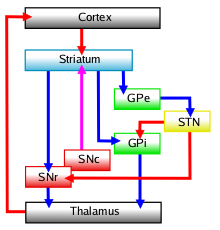Idea is based on basal ganglia dopamine neuromodulation described:
- https://en.wikipedia.org/wiki/Basal_ganglia#Circuit_connections
- https://github.com/max-talanov/1/blob/master/affective_computing_course/neurotransmission.md#emotional-loop
In short:
Connectivity diagram showing excitatory glutamatergic pathways as red, inhibitory GABAergic pathways as blue, and modulatory dopaminergic pathways as magenta. (Abbreviations: GPe: globus pallidus external; GPi: globus pallidus internal; STN: subthalamic nucleus; SNc: substantia nigra compacta; SNr: substantia nigra reticulata)
The antagonistic functions of the direct and indirect pathways are modulated by the substantia nigra pars compacta (SNc), which produces dopamine. In the presence of dopamine, D1-receptors in the basal ganglia stimulate the GABAergic neurons, favoring the direct pathway, and thus increasing movement. The GABAergic neurons of the indirect pathway are stimulated by excitatory neurotransmitters acetylcholine and glutamate. This sets off the indirect pathway that ultimately results in inhibition of upper motor neurons, and less movement. In the presence of dopamine, D2-receptors in the basal ganglia inhibit these GABAergic neurons, which reduces the indirect pathways inhibitory effect. Dopamine therefore increases the excitatory effect of the direct pathway (causing movement) and reduces the inhibitory effect of the indirect pathway (preventing full inhibition of movement).
This way we have to simulate:
- Cortex
- Striatum
- GPe: globus pallidus external
- GPi: globus pallidus internal
- STN: subthalamic nucleus
- SNc: substantia nigra compacta
- SNr: substantia nigra reticulata
With two main pathways/algorithms:
Direct pathway
Cortex (stimulates) → Striatum (inhibits) → "SNr-GPi" complex (less inhibition of thalamus) → Thalamus (stimulates) → Cortex (stimulates) → Muscles, etc.
Indirect pathway
Cortex (stimulates) → Striatum (inhibits) → GPe (less inhibition of STN) → STN (stimulates) → "SNr-GPi" complex (inhibits) → Thalamus (is stimulating less) → Cortex (is stimulating less) → Muscles, etc.
Neuromodulation is implemented by SNc via production of the dopamine that influences Striatum triggering direct or indirect pathway.
- Spikes generators of the Cortex generate series of spikes that stimulates the Striatum.
- Dopamine neurons produce dopamine that modulates Striatum.
- In case of dopamine relative cortex activity (number of spikes) is increased.
- In case of no dopamine modulation relative cortex activity (number of spikes) is decreased.
- Run some series of impulses that simulate loud sound in auditory cortex.
- Run noradrenaline neuromodulation that simulate attention switch.
- Run two steps above for training.
- Run step number one.
- This should initiate noradrenaline neuromodulation based on training, if we observe rise of noradrenaline concentration this should effectively indicate the association of noradrenaline neuromodulation with loud sound.
- Noradrenaline neuromodulation also should switch an attention in terms of computational processes concentrate the computing power and memory resources on the current processes associated with loud sound.
Series of impulses simulating loud sound.
- Noradrenaline neuromodulation
- Attention switch
- Concentration of computational power and memory resources on thinking process associated with loud sound.
None
Computational and memory resources are concentrated on current process associated with loud sound.
- Run some series of impulses that simulate quiet sound in auditory cortex.
- Run dopamine + serotonin neuromodulation that simulate reward.
- Run two steps above for training.
- Run step number one.
- This should initiate dopamine + serotonin neuromodulation based on training, if we observe rise of dopamine and serotonin concentration this should effectively indicate the association of dopamine neuromodulation with quiet sound as reward.
Series of impulses simulating quiet sound.
- Dopamine + serotonin neuromodulation
- Reward assignment
None
Reward assigned to the process associated with quiet sound.
